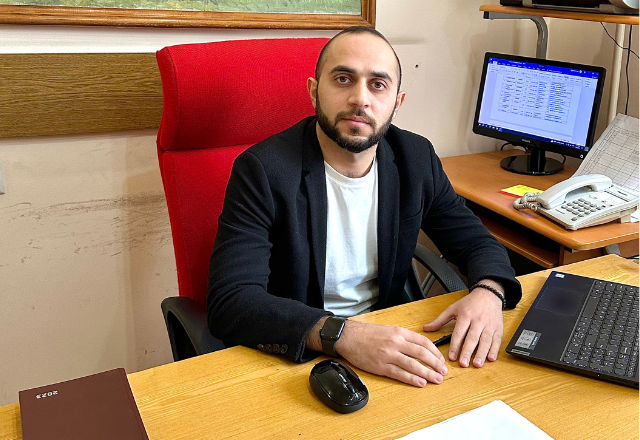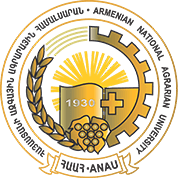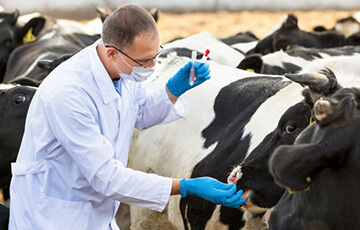
Zhirayr Chitchyan
Candidate of Sciences, Docent
Acting Chair
Contacts
- 74 Teryan, 0009, Yerevan, RA,
ANAU, V building, room #201, 202, 204, 205, 206, 212, 213, 214, 405, 407, 412, 414 - (+37412) 52- 36-78, (+37412) 52-53-65, (+37412) 52 92 72, int. 2-13, 3-92, 3-25, 3-84, 3-72, 2-62
- [email protected]
According to the resolution taken by the Rector of ANAU on December 5 in 2022, as a result of the structural changes made in the university the Chairs of Agricultural Animal Morphology, Physiology and Pathological Anatomy and Animal Husbandry were reunited and a new Chair of Morphology and Zoology was created.
For long years, lecturers of the former Chair of Morphology, Physiology and Pathological Anatomy have been engaged in serious scientific and research activities: the comparative anatomy of different organ-systems of the buffalo, the morphology of the of the Caucasian gray breed, Yerevan and Legorn chickens breeds, the anatomical changes of the motor organs of the young beef under complex conditions, and later, the anatomy of the sheep of the Armenian semi- rough wool sheep breed, especially the Aragats and Martuni types, were comprehensively studied.
Issues of stimulation for post-traumatic regeneration of tissues and organs of various animals, the embryogenesis of some organs of birds and mammals, as well as the caruncle-catledon connection of pregnant cows and the causes and prevention of retention of the uterus in the postpartum period were investigated. Pathological changes in the mammary glands of cows with hidden mastitis were also studied.
Valuable researches have been carried out to determine the physiological and biochemical properties of the natural gastric juice of dogs, the biological and therapeutic significance of the gastric juice and its direction of application have been clarified.
The physiological and pathological effects of microelements on the organism of animals, as well as the biological and high-dose effects of molybdenum, cobalt, copper on the functions of organ systems were investigated.
Over the years, the lecturers of the chair have published textbooks, educational manuals, a trilingual anatomical dictionary, thousands of scientific articles, methodological instructions and many textbooks have been translated.
In recent years, under the supervision of the professor N. Kh. Under Grigoryan, the chair’s professors and graduate students researched the adaptation of farm animals and birds, their natural endurance in different conditions of feeding and behavior during the ontogenesis. Effective researches have been carried out on different breeds of sheep, adaptation mechanisms have been developed in the foothills and mountain zones.
The results of those researches have been repeatedly reported and published in republican and foreign international journals and scientific conferences.
The academic museum, adjacent operating to the chair, is unique among similar museums in many countries. More than 4,000 unique exhibits related to different organ systems are displayed there: skeletons of various representatives of the animal world, scarecrows, internal organs, congenital abnormalities of various types and other didactic materials of interest.
The voluminous materials, collected over 90 years as an invaluable values, are presented in the form of numerous museum exhibits: skeletons of animals, fish, amphibians, reptiles, birds and mammals (360 pieces), scarecrows (250 pieces), numerous preparations of different nature related to all organ systems (1385 pieces), unique anomalies (25 pieces), animals’ and birds’ corpses, autopsies and separate organs kept in formalin solutions (1500 pieces), mock-ups (150 pieces), archaeological samples (50 pieces), patho-anatomical preparations (250 pieces).
Today, the Anatomical Science Museum is one of the first in the number and quality of its exhibits among similar museums of the former USSR, surpassing even the Moscow Anatomical Museum of the University of Veterinary Medicine and Biotechnology named after K. Skryabin.
The chair of private livestock breeding was established in 1930, the founder and the head was academician A.Z. Tamamshev (Tamamshyan). For different years, the chair was headed by professors Yu.G. Marmaryan, Sh.S. Nersisyan, G.H. Giloyan, R.T. Sargsyan, and since 2009 up to now it has been headed by docent T.Zh. Chitchyan. The chair of breeding and feeding of agricultural animals (the chair of Animal Husbandry, until 2005) was formed in the result of unification of Yerevan Veterinary Medicine and Animal Husbandry Institute of Feeding and Breeding of agricultural animals and the Chairs of Animal Breeding of Armenian Agricultural University.
In 1997-2017 the chair was headed by V. Abrahamyan.
In 2017 in result of partial structural changes the Chairs of Animal Husbandry and Breeding and Feeding of agricultural animals were unified into the chair of Animal Husbandry.
Many scientific and productive works were carried out in the chair, including creation and improvement of breeds of agricultural animals and birds breeds in Armenia, feeding of agricultural animals and birds, the innovation techniques of animal husbandry, reproduction of herd and flock, as well as using natural resources as additional mineral food (bentonite clay, zeolite, travertine) for animals.
A number of lecturers of the chair carry out scientific research on “Ways to increase the production of livestock products by improving the technologies of management of the branch” funding by the state. The young scientists of the chair are engaged in the study of the nutritional and the biological peculiarities of feeding and biological properties of beef imported to the republic, as well as the problems of beekeeping.
The educational-methodological publications are of great importance to the chair. More than 171 textbooks and manuals, 119 educational methodological instructions and 1521 scientific articles were published, 11 doctorates and 21 dissertations were defended, 6 copyright and 9 decree on selection achievement were received and dozens of instructions have been developed.
The lecturers of the chair closely cooperate with pedigree leading livestock farms, carrying out work on the improvement of herd and flock pedigree food characteristics, breeding, reproduction, inculcation of new and advanced technologies of behavior.
Within the framework of “Livestock Agribusiness” project, trainings for young farmers are conducted in rural areas, competitions and presentations are held /Amchor/. The chair staff collaborates with UN Development Program, Strategic Development Agency, ICARE, GIZ and other state and public organizations. The chair staff collaborates with UN Development Program, Strategic Development Agency, ICARE, GIZ and other state and public organizations.
In the recent years a lot of attention has been paid to obtaining high-quality and safe foods, animal welfare, as well as farming issues depending on climate changes and organic farming. The Chair is the co-organizer of the “Smart Livestock Building” program subsidized by the RA government. For these and other similar issues, the head of the chair, T. Chitchyan, associate professors: Zh. Chitchyan, A. Azizyan, Z. Pambukhchyan. Consultations on these and other similar issues with leading farms of all the regions are held by the head of the chair Tigran Chitchyan, docents: A. Azizyan, Z. Pambukhchyan.
The Chair of Morphology and Zoology carries out the educational process of the students in a number of specialties of ANAU, applying innovative technologies and methods, matching the curricula as much as possible with the curricula for such professions abroad, so that the specialist diplomas issued by the university are later adopted in many countries of the world and the graduates of the university be required by employers.
Chair Staff
- Nshan Grigoryan – Doctor of Sciences, Professor
- Razmik Mkhitaryan – Doctor of Sciences, Professor
- Surik Kobelyan – Doctor of Sciences, Professor
- Ashkhen Grigoryan – Doctor of Sciences, Docent
- Margarita Mirzoyan – Candidate of Sciences, Docent
- Anna Aghajanyan – Candidate of Sciences, Docent
- Lianna Vardanyan – Candidate of Sciences, Docent
- Artur Harutyunyan – Candidate of Sciences, Docent
- Zorik Pambukchyan – Candidate of Sciences, Docent
- Arevik Azizyan– Candidate of Sciences, Docent
- Zhirayr Chitchyan – Candidate of Sciences, Lecturer
- Gayane Poghosyan – Candidate of Sciences, Assistent
- Astghik Adamyan – Specialist
- Hasmik Karakhanyan – Specialist
- Naira Rshtuni – Specialist
- Narine Mkrtchyan – Specialist
- Armine Jilavyan – Specialist
Subjects
Anatomy of domestic animals
Cytology, Embryology, Histology
Physiology of agricultural animals
Morphology of agricultural animals
Ethology and Bioethics of agricultural animals
Radiobiology
Pathological Physiology
Pathological Anatomy
Histopathology
Autopsy and Forensic Expertise
Animal Husbandry
Commodity science and standardization of animal origin products and raw materials
Commodity science
Agricultural animals feeding
Technology of obtaining raw materials
Basics of Animal Husbandry
Basics of Agricultur
Organic Animal Husbandry
Characteristics of meat and meat products
Product characteristics of milk and milk products
Product characteristics of fish and fish farming
Product characteristics of eggs and egg products
Food fat merchandising characteristics
Mechanization of livestock farms
Academic literacy and research methods
Quality management and certification of livestock products
Business project management
Veterinary legislation
Bioethics
Principles of animal feeding
Selection modeling and animal breeding programs
Quality management of animal products
Animal Ethology
Structure and physiology of animal skin and its derivatives
Structure and physiology of the locomotor system of animals
Structure and physiology of digestive, respiratory and genitourinary organs of animals
Structure and physiology of blood and lymphatic system of animals
Structure and physiology of the nervous system and endocrine glands of animals
Treatment and prevention of bird disease
Fish Diseases
Laboratory sampling








